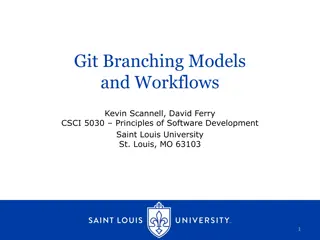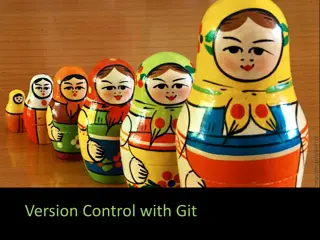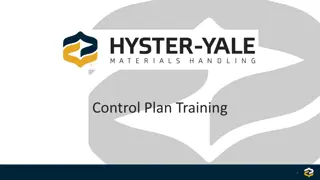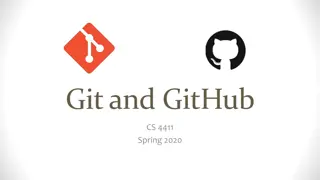Effective Git Version Control Strategies for Collaborative Development
Git version control system provides a powerful way to manage code changes efficiently, allowing for collaboration and seamless integration of developments. This presentation explores key concepts of Git, including branching, merging, commit messages, and workflows. By following best practices such as writing clear commit messages and understanding different merging options, developers can enhance productivity and maintain a well-organized codebase for successful teamwork.
Download Presentation

Please find below an Image/Link to download the presentation.
The content on the website is provided AS IS for your information and personal use only. It may not be sold, licensed, or shared on other websites without obtaining consent from the author.If you encounter any issues during the download, it is possible that the publisher has removed the file from their server.
You are allowed to download the files provided on this website for personal or commercial use, subject to the condition that they are used lawfully. All files are the property of their respective owners.
The content on the website is provided AS IS for your information and personal use only. It may not be sold, licensed, or shared on other websites without obtaining consent from the author.
E N D
Presentation Transcript
Lecture 2: Hands-on example of working with git Open-Source Energy System Modeling TU Wien, VU 370.062 Dipl.-Ing. Dr. Daniel Huppmann This presentation is licensed under Creative Commons Attribution 4.0 International License a Creative Commons Attribution 4.0 International License
Part 1 Working with git version control Open-Source Energy System Modeling, Lecture 1 Daniel Huppmann 2
A quick introduction to version control using git Git is so much more than just keeping track of code changes over time Key differences between git version control vs. folder synchronization (e.g. Dropbox, Google Drive) You define the relevant unit or size of a change by making a commit Adding comments to your commits allows to attach relevant info to your code changes Branches Branches allow you to switch to a "parallel universe" within a version control repository It s a decentralized version control tool that supports offline, parallel work There is a well-defined routine for merging merging developments from parallel branches commit Several git implementations (e.g., GitHub) provide additional project management tools User interfaces for code review using pull requests pull requests Issue tracking and discussion, kanban boards, ... However, keep in mind that git is great for uncompiled code and text with simple mark-up Use other version control tools for data, presentations, compiled software, ... Open-Source Energy System Modeling, Lecture 1 Daniel Huppmann 3
A full git workflow Git is a decentralized version control system geared for collaboration The internet (e.g. GitHub) Your computer The remote remote repository of the official codebase Your remote remote copy (fork of the repository origin fork) git clone clone of the repo local Staging area Working directory upstream clone checkout fork commit push add fetch checkout pull-request pull fetch Open-Source Energy System Modeling, Lecture 1 Daniel Huppmann 4
Branching and merging with git There are multiple methods to bring parallel developments back together merge the changes from dev into master Three options to merge Getting started with branching 1) A merge commit 2) Rebase 3) Squash and merge ... a commit dev dev dev dev main main main main Open-Source Energy System Modeling, Lecture 1 Daniel Huppmann 5
Writing good git commit messages If at the end of the day/week/year, you don t remember what you did... Useful recommendations to help you (and your colleagues) keep track of your work Limit the subject line (summary) to 50 characters Capitalize the subject line Do not end the subject line with a period Use the imperative mood in the subject line Use the body to explain what and why vs. how A properly formed Git commit summary should be able to complete the following sentence: If applied, this commit will your subject line here If applied, this commit will update getting started documentation If applied, this commit will release version 1.0.0 If applied, this commit will merge pull request #123 from user/branch Selected items from chris.beams.io/posts/git-commit/ Open-Source Energy System Modeling, Lecture 1 Daniel Huppmann 6
Part 2 Setting up a simple repository with unit tests and continuous integration The first rule of live demos: Never do a live demo. So let s do a live demo. Open-Source Energy System Modeling, Lecture 2 Daniel Huppmann 7
Hands-on exercise: github.com/danielhuppmann/lecture-spring-2023 Set up a new public GitHub repository at www.github.com Add a license (why not start with APACHE 2.0?) Update the README (formatting using markdown) Clone the repository to your computer (recommended for novices: gitkraken.com) Add the license statement and the badge to the readme Start developing a little Python function (recommended for novices: anaconda.com) Add a unit test Add a gitignore file Add continuous integration using a new branch GitHub Actions to execute unit tests stickler-ci to implement linter and code style verification Create a pull request to execute the CI and merge the new branch into `main` Open-Source Energy System Modeling, Lecture 2 Daniel Huppmann 8
Hands-on exercise (Part II) If a non-admin user wants to push commits, you have to fork the repo (create a copy under your GitHub user) Clone the fork to your computer Start a new branch Add a new function or extend some feature such that the unit tests fail Make a pull request to the upstream repository Fix the code such that unit tests pass Ask someone else to perform code review Merge the new development (by an admin) Add contributing guidelines, set up templates for pull requests Create a release Open-Source Energy System Modeling, Lecture 2 Daniel Huppmann 9
Part 3 Some practical considerations and advice Open-Source Energy System Modeling, Lecture 2 Daniel Huppmann 10
Time allocation for increasing efficiency through automation Is it worth the time to automate repetitive tasks? Probably not really... xkcd by Randall Munroe Open-Source Energy System Modeling, Lecture 2 Daniel Huppmann 11
Good enough scientific programming You don t have to have a PhD in IT to do decent scientific programming! In fact, it might actually help... Data management: save both raw and intermediate forms, create tidy data amenable to analysis Software: write, organize, and sharing scripts and programs used in the analysis following best practices Collaboration: make it easy for existing and new collaborators to understand and contribute to a project Project organization: organize the digital artefacts of a project to ease discovery and understanding Manuscripts: write manuscripts with a clear audit trail and minimize manual merging of conflicts Adapted from Greg Wilson et al. Good enough practices in scientific computing. PLoS Comput. Biol. 13(6), 2017. doi: 10.1371/journal.pcbi.1005510 Open-Source Energy System Modeling, Lecture 2 Daniel Huppmann 12
Good enough scientific programming Software Your worst collaborator? Yourself from six months ago... Place a brief explanatory comment at the start of every program. Do not comment and uncomment sections of code to control a program's behaviour. Decompose programs into functions, and try to keep each function short enough for one screen. Be ruthless about eliminating duplication. Always search for well-maintained software libraries that do what you need. Test libraries before relying on them. Give functions and variables meaningful names. Make dependencies and requirements explicit. Provide a simple example or test data set. Submit code to a reputable DOI-issuing repository (e.g., zenodo). Adapted from Greg Wilson et al. Good enough practices in scientific computing. PLoS Comput. Biol. 13(6), 2017. doi: 10.1371/journal.pcbi.1005510 Open-Source Energy System Modeling, Lecture 2 Daniel Huppmann 13
Code style guides Programming should be seen as a (not foreign) language Which programming language to use, which other conventions to follow? If you don t have a strong preference: follow the community or your room (office) mate! Some practical guidelines: Follow a coding etiquette, e.g., Black & PEP8 for Python, Google s R style guide For larger projects, agree on a folder structure and hierarchy early (source data, etc.) Only change folder structure when it s really necessary For more complex code (e.g., packages), use tools to automatically build documentation such as Sphinx and readthedocs.org Keep in mind... Code is read more often than it is written Good code should not need a lot of documentation Key criteria: readability and consistency with (future) collaborators and yourself! Open-Source Energy System Modeling, Lecture 2 Daniel Huppmann 14
Software releases and semantic versioning If a piece of software is used by multiple people, clear versioning is critical 0.1 Semantic versioning uses a structure like <MAJOR>.<MINOR>.<PATCH> 0.1.1 For a new release (i.e., a published version), you MUST increment... MAJOR when making incompatible API changes, MINOR when adding backwards-compatible functionality, PATCH when making backwards-compatible bug fixes. Initial 0.1.2 development 0.2 0.2.1 First release 1.0 Other considerations: Major version zero (0.y.z) is for initial development. Anything may change at any time. Version 1.0.0 defines the public API. After that, rules above must always be followed. 1.0.1 1.0.2 1.1 Downstream version numbers MUST be reset to 0 when incrementing a version number. 1.2 You MAY increment when substantial new internal features are added. A pre-release version MAY be denoted by appending a string, e.g., 1.0.0-alpha. 1.2.1 Adapted from Semantic Versioning 2.0.0, semver.org 2.0 Open-Source Energy System Modeling, Lecture 2 Daniel Huppmann 15
Coding etiquette Keep in mind that the internet remembers everything When you search for my colleague Matthew Gidden on Twitter, the first tweet you find is... Open-Source Energy System Modeling, Lecture 2 Daniel Huppmann 16
Social etiquette Be kind and respectful in collaboration, code review and comments Collaborative scientific programming is about communication, not code... It s about the people! And don t be annoyed when, sometimes, some collaborators are stubborn... Keep in mind that discussions via e-mail, chat, pull requests comments, code review, etc. lack a lot of the social cues that human interaction is built upon If there are two roughly equivalent ways to do something and a code reviewer suggests that you use the other approach... Just do it her/his way if there is no good reason not to out of respect for the reviewer and to avoid getting bogged down in escalating discussions Give credit generously to your collaborators and contributors! Open-Source Energy System Modeling, Lecture 2 Daniel Huppmann 17
Homework assignment Create a simple repository based on any of your real-life projects Start a new GitHub repository, add a license and set up continuous-integration (CI) tools Add functions or small features from any real-life project relevant to your work or interests The codebase should include 2-4 functions, 20-40 lines of code including documentation including documentation The repository should work as stand-alone project (i.e., no need for other parts of your project/work that are not part of this repository) If you need any dependencies/packages, add a simple list in a file requirements.txt Add at least one test per function and make sure that these are executed on CI If data is necessary to understand the scope of the functions, add a stylized dataset The README should explain the scope of the project and the purpose of the functions Invite me as a collaborator to your repository when the project is ready to be reviewed/graded Programming languages: Python (preferred), R, Julia Invitation to collaborate due by Monday, April 10, 23:59 (please do not push any commits after) Open-Source Energy System Modeling, Lecture 2 Daniel Huppmann 18
Thank you very much for your attention! Dr. Daniel Huppmann Senior Research Scholar Energy, Climate, and Environment Program International Institute for Applied Systems Analysis (IIASA) Schlossplatz 1, A-2361 Laxenburg, Austria huppmann@iiasa.ac.at huppmann@iiasa.ac.at @daniel_huppmann @daniel_huppmann @daniel_huppmann@mastodon.social @daniel_huppmann@mastodon.social www.iiasa.ac.at/staff/daniel-huppmann www.iiasa.ac.at/staff/daniel-huppmann This presentation is licensed under Creative Commons Attribution 4.0 International License a Creative Commons Attribution 4.0 International License























